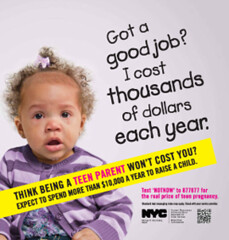
Poster for New York City’s “Real Cost of Teen Pregnancy” campaign. Via NYC.gov
This month, New York City launched a new campaign called “The True Cost of Teen Pregnancy.” The 4,000 bus and subway posters, which reportedly took two years of planning and cost the city $400,000, feature wailing toddlers and babies (mostly of color) next to captions such as Honestly, Mom, chances are he won’t stay with you… and I’m twice as likely not to graduate high school because you had me as a teen.
Yes, teen pregnancy is experienced disproportionately by girls of color and girls living in poverty. Yet data shows that national teen pregnancy rates across ethnicities are dropping not rising, including in New York City. So why this public health campaign? And why now?
The
race and class politics behind the “True Cost” campaign become more
obvious when one considers that over the past years, the city has
released several public health campaigns that have been critiqued as
specifically targeting working class and poor communities of color.
Indeed, public health campaigns are never value neutral, and are often
used to orient social hostility toward marginalized groups.
While “True Cost” was quickly criticized, most
of the pushback has focused on the problems surrounding the use of
shame as a health promotion tool, not explicitly around its race and
class message. For instance, the New York City Coalition for
Reproductive Justice launched a ‘No Stigma! No Shame!’ campaign in response to the ad, and Planned Parenthood of New York City released a statement denouncing
the posters, saying they perpetuated “gender stereotypes, stigmatizing
and fear based messages” while ignoring the ‘structural realities’
impacting these young women’s lives (Code for racism and classism?
Perhaps).

Then
there is Richard V. Reeves, a senior fellow at the Brookings Institute,
who defended the use of stigmatization and fear as motivations for
healthy behavior in a column for the New York Times, arguing that “shame is an essential ingredient of a healthy society.”
But Reeves’ voice has seemingly been an outlier. Even TED talk ‘shame and vulnerability’ rockstar Brené Brown has gotten into the conversation,
arguing against Reeves’ conclusions by asserting, “Shame diminishes our
capacity for empathy. Shame corrodes the very part of us that believes
we are capable of change.”
But
I don’t think the issue is purely about shame. The question is: who is
being shamed and for what purpose? It is not a coincidence that New
York’s current campaign shares a lot in common with a Georgia hospital’s
2011-2012 campaign against childhood obesity. Like
the “True Cost” ads, these black and white photos of morose looking
children were accompanied by fear-filled captions like WARNING: Chubby kids may not outlive their parents and WARNING: It’s hard to be a little girl if you’re not.
Both campaigns use children (the universal “innocent victims”) to blame parents – a strategy seen often in international development projects, such as Invisible Children’s problematic KONY 2012 campaign. In these narratives, entire communities, or countries, are portrayed as incapable of, or uninterested in, protecting and caring for their own children, or themselves. (Which then justifies everything from domestic governmental regulation to international interference in, or invasion of, other countries)
To read the rest of this essay, please visit Racialicious!
No comments:
Post a Comment